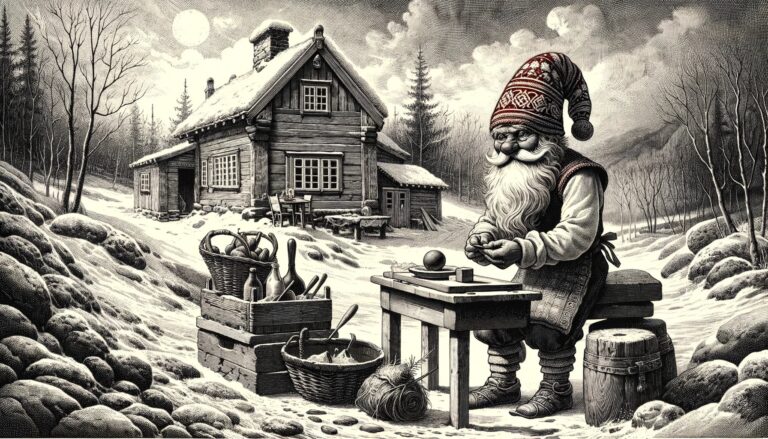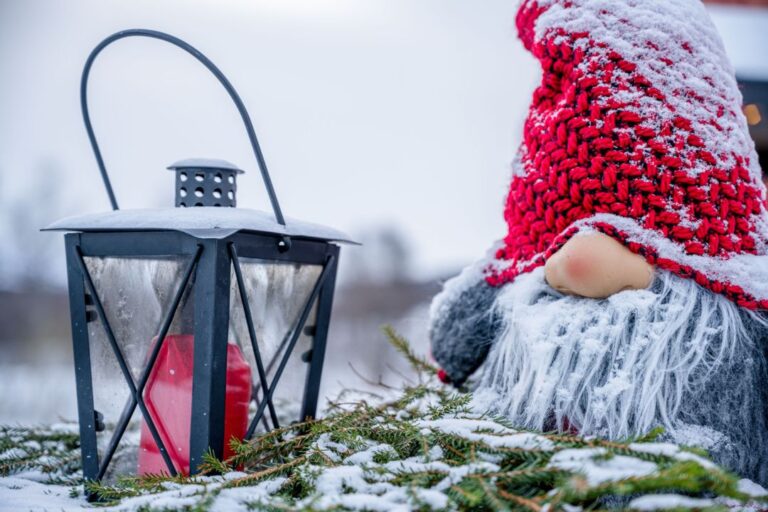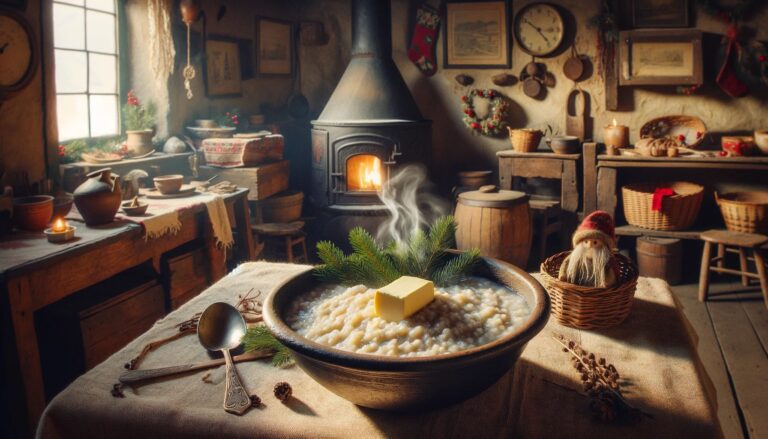Some stories have been with us for what seems like forever. The legend of the Norwegian nisse is an example of such a timeless tale. Here's what you need to know about this curious creature.
As the autumn twilight descends on the land and you admire the dusky landscape, you may well get convinced that you spotted one in the shadows. But who are these enigmatic figures, where do they come from, what do they look like and are they good or evil?

So get cosy and prepare to blur the line between the seen and the unseen. Let’s unravel together the many mysteries of the Norwegian nisse (plural: nisser) and find out why they have fascinated Scandinavians for countless generations.
The Origins of the Norwegian Nisse
The origins of the word “nisse” (pronounced “nee-suh”) are unclear. Some say it’s a short version of the name Nils – the Nordic form of Nicholas.
In that case, it would have come to Norway via Denmark, sometime after the 16th century. Another hypothesis is that the word is derived from Old Norse niðsi, meaning “dear little relative”.
The English translation of the word varies from one work to the other. Some translators use the term “gnome”, others “pixie” or even “elves”.
The word “goblin” has even been used to translate “nisse” in Danish author Hans Christian Andersen's fairy tales. This translation may not work as well today, since it brings to mind the monstrous creatures depicted in the Lord of the Rings novels and films.
The Swedes use a different word which can shed light on the origins of the legend. A “nisse” in Swedish is called a “tomte”.
In Scandinavian languages, a “tomt” is a plot of land. A “tomte” is a gnome of sorts that is associated with the plot of land.
This gives credence to the theory according to which the nisse is a remnant of ancestral worship on farms in pre-Christian times.
At that time, the farm's founder and clearing man, who was often buried in a burial mound on the farm, received sacrificial offerings in the form of food and beer for the major holidays of the year – including the winter solstice, or Christmas.

The purpose of the offerings to this ancestral spirit was to ensure growth, peace, and fertility. Eventually, the “spirit” morphed into a “nisse” being a small man who tended, combed, and brushed the animals, and who protected both animals and people on the farm against evil powers.
What Does the Norwegian Nisse Look Like?
According to tradition, the nisse is short in stature, with a wrinkled old man's face with white or grey beard. He wears a red top hat, grey woollen trousers, and jacket.
He is shod with wooden clogs, or fine shoes with silver buckles. Usually, the nisse is invisible, but occasionally one can catch a glimpse of him.
Even if he doesn’t show himself, he is never far away, and he keeps an eye on what happens on the farm. Today, nisse figurines are commonly on display at Christmas, and feature a grey beard, a red pointy hat, a knitted sweater and some leather or felt shoes.
Behaviour of the Norwegian Nisse
In olden days, Norwegian nisser had a reputation for being quick-tempered, capricious, and taking joy in others’ misfortune.
That doesn’t mean they were entirely malevolent, though. They were known to help out on the farm, often at night, away from prying eyes.
It was therefore wise to keep on friendly terms with them. The last thing you need is fantastical creatures causing trouble, so people would set out food and drink for them at important holidays.
We mentioned earlier how the tradition of the Norwegian Nisse dates back to pre-Christian times. The process of Christianisation did not end people’s belief in the nisse, but changed its significance a bit.

A farmer’s crops growing better than his neighbours’ could trigger accusations that he was in cahoots with a nisse, doing “ungodly work” for him. In a staunchly Christian society, finding oneself at the receiving end of such rumours could be quite damaging indeed.
The Norwegian Nisse in Modern Times
From the 19th century and onwards, nisse were included in literary works (such as the previously mentioned fairy tales by Hans Christian Andersen). Some characteristics of them were emphasised at the expense of others, and over time the visual appearance of the nisse as we know it today began crystallising.
The romantic nationalism period, in the second half of the 19th century, is when the nisse was cemented as a Norwegian symbol. Christmas cards and booklets became popular, and were often illustrated with designs featuring nisse.
From then on, the image of the nisse with its beard and red pointy hat was part of the collective consciousness – so much so, in fact, that they became a symbol of resistance.
The Nisse as a Symbol of Resistance
Norway had a period of alcohol prohibition in the early 20th century. Much like in the US, prohibition did not mean everyone stopped drinking.
A thriving underground market of spirits production and import took hold. This was often represented in anti-probihition flyers and postcards as paintings of cunning nisser in boats bringing countless bottles or barrels from abroad.
The Norwegian nisse was also a symbol of protest and resistance during the nazi occupation, from 1940 to 1945. A Stavanger print shop owner issued a series of nine Christmas cards in Christmas 1941, where a nisse wished Merry Christmas to all Norwegians.
On December 22 of the same year, all the country's post offices were ordered to confiscate these cards. So powerful was nisse imagery as a symbol of resistance that the nazis went as far as to forbid people from wearing red hats.
Nisse imagery as a symbol of resistance and Norwegianness experienced a resurgence during the referendums on EU membership of 1972 and 1994.
Julenisse: The Norwegian Santa Claus
Santa Claus is called “julenisse” in Norway. Like Santa Claus, the Norwegian Julenisse is believed to be based on legends about Saint Nicholas, a bishop who lived in what is now Turkey around the 3rd century.
He was known for his generosity and concern for the poor, and the tradition of giving gifts on his feast day, December 6th, started in the Middle Ages and spread across Europe. In contemporary times, children thinking of “julenisse” are likely to think of the “Coca-Cola Santa Claus”, with his bright red outfit trimmed in white fur.

Traditionally however, the Norwegian version of Father Christmas is depicted as a friendly older man with a robust white beard and smiling eyes, dressed in woollen grey trousers, a long jacket, big boots, and a red hat.
When it comes to personality, the julenisse borrowed traits from the “regular” nisser we described earlier. He was known to be temperamental, and appeasing him with offerings of Christmas porridge was wise.
The Julenisse borrows other elements from Norway’s already existing nisse folklore. For example, while Santa Claus has elves to help him, the Julenisse can rely on the support of fjøsnisser (barn gnomes) for his work.
In today’s Norway, you are just as likely to encounter depictions of the “Coca Cola Santa Claus” as you are of seeing the traditional Julenisse. For a chance at spotting traditional Julenisse imagery on a trip to Norway, try one of the country’s many Christmas markets.
Do your Norwegian friends and family have local traditions or myths involving a nisse? We'd love to hear your stories in the comments, below.


My grandmother was born in Norway, but her family immigrated to Canada pre-WWII – she later immigrated to the U.S. My siblings and I grew up going with her to the Sons of Norway lodge when we visited her. During Christmas time she had what we thought were elves scattered throughout her house. She seemed to really value them and now we know why. Thank you for the article.
You’re welcome!